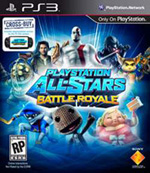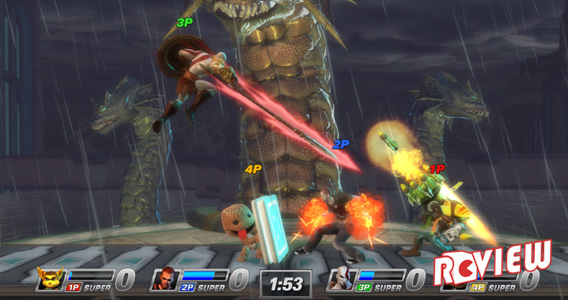
When PlayStation All-Stars Battle Royale was announced it immediately drew comparisons to another popular game series, and it’s not hard to see why. All-Stars practically begs to be measured against Nintendo’s Smash Bros. franchise.
Normally I would try to avoid a point-for-point comparison of two titles, but All-Stars pulls so much from the Smash Bros. games—without even a hint of subtlety—that I think it’s only fair to compare the two, mercilessly. You can expect to find many such comparisons ahead.
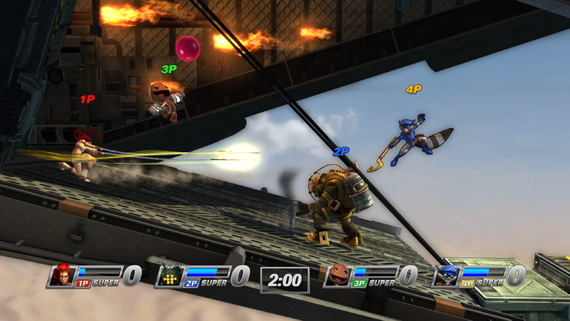
As this is a game that’s built upon the concept of mixing franchises, the first concern is, of course, the stable of characters. The roster includes newer and more recognizable properties as well as several more obscure ones, and the roster is fairly complete—though there were a few head scratching absentees (Crash Bandicoot?). Contrasting Smash Bros., All-Stars draws only one playable character from each of the leveraged IPs (with the exception of Infamous, from which both a good and evil version of Cole appear). This means that more IPs are included, but also means some missed opportunities—like Solid Snake or Dante’s brother, Vergil.
The success of the title thus hinges on the successful implementation of these source IPs, and thankfully the fighters’ fidelity to their home franchises and original incarnations is impressively thorough. Jump through the air as Nathan Drake and he’ll perform the same haphazard leap as seen in Uncharted, frame for frame. Attacks and combat animations are pulled directly from source titles, such that the first time I played as Dante I intuitively knew to execute a helmbreaker from having played past Devil May Cry games.
Fighter styles and combat moves are comprehensive and clever; Drake can take cover behind a magically appearing chest-high cover wall, Cole can extend his jump with static boosters, and Radec can snipe enemies from across the arena. Meanwhile, mercifully absent are the cloned movesets that popped up from time to time in the Smash Bros. series.
Combat is simplistic at first glance, but provides a comfortable amount of depth and variety that players will immediately feel the need to learn and specialize in one character. Combos and the application of specific attacks to break enemy defenses are emphasized.
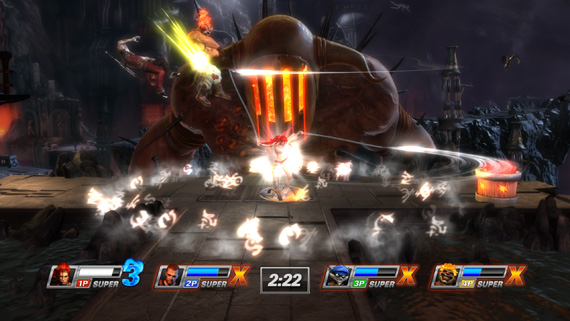
In the standard four player battles that are going to be the bread and butter of this title, gameplay is an absolute blast—and it should be, since it was a blast thirteen years ago in Super Smash Bros. It’s exciting, frantic, and explosive—and if you get all four players in the same room, even more so.
The core difference in combat between All-Stars and Nintendo’s alternative is knockouts. Rather than being knocked out of the ring, characters are obliterated in flashes of light (“knocked out”) by special super moves. Regular attacks cannot knockout opponents; they merely build energy for a three-tier meter that can then be used to unleash increasingly powerful super attacks.
On these, my opinion is mixed. There’s a level of strategy here; the better one knows a character, the easier it is to gauge when to deploy a special move and when to let the meter continue building. For Kratos, executing a special before level 3 is a waste—and successfully executing a level 3 attack can completely change the course of the game. Conversely, for Heihachi, waiting to get to level 3 has almost no payoff and is likely to lose you the match.
Wrestling energy out of other players and trying to guess their strategy adds an interesting layer to gameplay, though, at the same time, renders the core combat a little unsatisfying. In the Smash Bros series, success depends on executing the right attack at the right time—the difference, however, is that there’s always a “right attack” to execute. Characters have a wealth of powerful attacks that can potentially ring-out opponents under the right circumstances. All-Stars, by contrast, has only three “right attacks.” If a character is not sufficiently energized to execute one of these, there is no way to score and thus little else to do but keep punching.
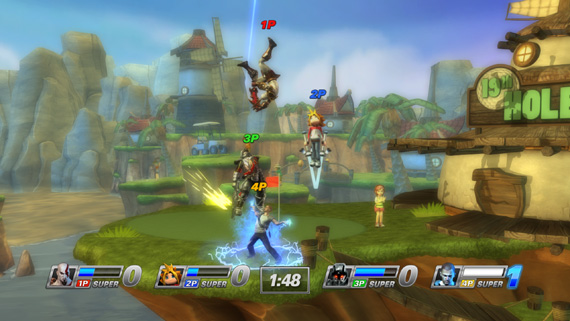
Meanwhile, balance is a little curious; within my group of players, everyone joked that the more closely Sony holds a property to their heart, the more likely the corresponding character is to be—how shall I put this?—complete OP bullshit. Number one with a bullet is Kratos, from whom all players should expect repeated thrashings in the online arena.
In terms of game modes, the options are sparse. In addition to the straightforward arcade mode, the game employs versus matches of the time, stock and kill-based varieties, as well as an online option in both ranked and unranked matches. None of the details particularly change the way the game is played, with only the occasional one-on-one match providing a substantially different experience from the frantic four player brawls.
Frustratingly, I found that when joining online games my character was occasionally changed at random—which is particularly damning in ranked games. If I’m expecting to compete as Raiden, it’s hardly acceptable that I be mysteriously deployed as Fat Princess.
Also available are combat trials, but these are mainly a means of squeezing every last drop of efficiency from a character and have little entertainment value on their own. All the same, they remain a fair resource for players looking for total expertise.
The feature of note is probably the inclusion of a free downloadable copy of the Vita version of the game. Progress is tracked between versions—meaning achievements and other unlocks earned on the console will transfer to the Vita and vice versa. Cross play is also supported, meaning players can face off against console opponents while on the go.
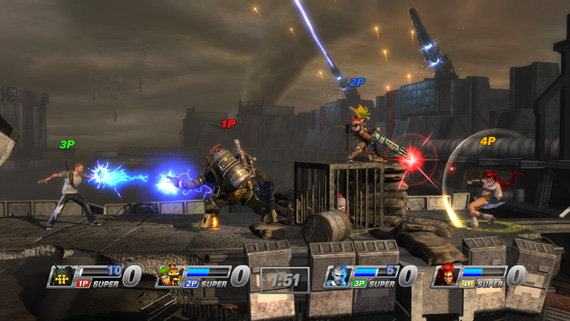
Though the game never manages to find its own identity, players could do a lot worse than a solid Smash Bros. clone. This game was clearly designed, beat for beat, with the more established franchise firmly in mind, and with only a handful of trivial differences introduced to distinguish it. Even the style and atmosphere directly apes the Nintendo series, and rather shamelessly, at that. While I would like to evaluate this title purely on its own merits, the thorough mining of the Smash Bros. titles means that for anyone who’s ever played both, it will be impossible to avoid comparing All-Stars to the games that inspired it.
Though the PlayStation imitation is solid, it’s difficult to come away looking favorable in a comparison like that. Smash Bros. has had three games to refine and expand its content; All-Stars comes away feeling like a sequel, except one with less going for it than its predecessor.
Battle Royale remains a solid multiplayer title, especially when played locally, but beyond that there just isn’t a lot of content here. Alternate costumes, taunts and the like may round out some additional play time, but a lack of unlockable characters or stages and only basic games modes sort of make this title feel like “Sony’s First Fighter.” Fortunately, deeply exciting gameplay and faithful mining of PlayStation franchises save this title from mediocrity, though you’re likely to come away feeling that Nintendo deserves more of the credit.
SuperBot Entertainment, SCE Santa Monica Studio
Publisher
Sony Computer Entertainment
System
PlayStation 3, PlayStation Vita (PlayStation 3 Reviewed)
Modes
Singleplayer, Multiplayer
Release Date
November 20, 2012
*A copy of this title was provided by the publisher for review
